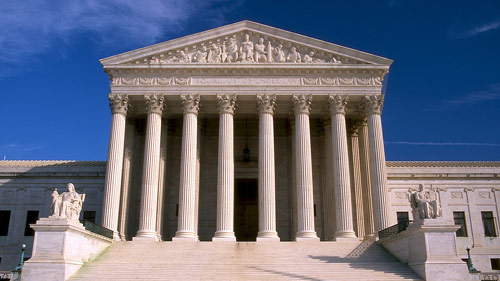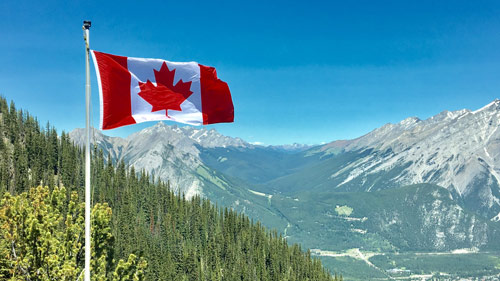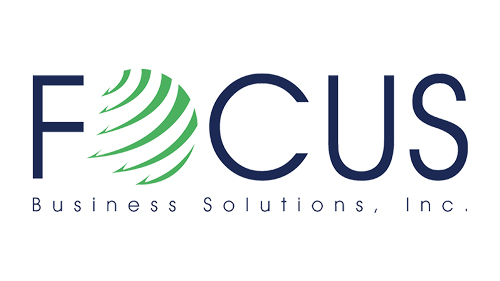USMCA Certificate of Origin Form
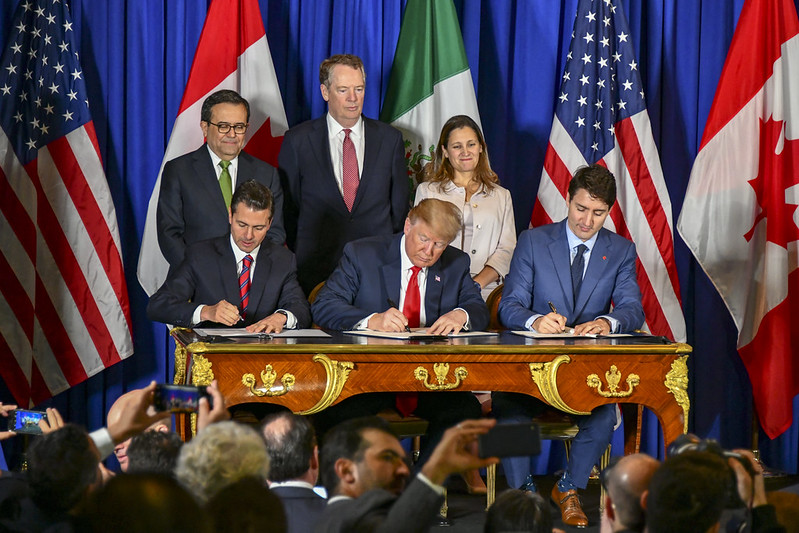
The United States Canada Mexico Agreement (USMCA) replaces the North America Free Trade Agreement (NAFTA) on July 1, 2020. Parties wishing to import “originating goods” duty free into the United States, Canada, and Mexico utilizing the preferential benefits of the USMCA must have a valid certificate of origin on file at time of claim, completed by either the Exporter, the Producer, or the Importer.
They must be able to provide the certificate used to claim duty free preferential benefits upon request of the relevant Customs authorities in the US, Canada, or Mexico. They must also be able to provide the support proving “originating goods” status that formed the basis of their certification. Penalties/Fines can be issued by Customs authorities for failure to comply with these requirements.
There is currently no official, government issued, or government approved United States Mexico Canada Agreement (USMCA) Certification of Origin. Per the text of the agreement, all certifications must contain a set of “minimum data elements.”
This website and the downloadable document were created and reviewed by trade professionals and based on the “minimum data element” requirements found in U.S. Customs and Border Protection’s (CBP) USMCA Interim Implementing Instructions published April 20, 2020, together with additional data elements compiled to align with other USMCA documents circulating in the industry.

Download a sample USMCA Certificate of Origin Form
Last Update: July 22, 2020
DOWNLOAD NOW
DISCLAIMER
It is intended this website and downloadable document may, at the USER’S discretion and own risk, be utilized for reference purposes and is not intended as definitive and/or authoritative for claiming USMCA benefits. The authors of this website and downloadable document do not warrant its content and/or use. By visiting this website and/or downloading the document(s) the USER agrees to bear the ultimate responsibility for deciding whether or not to use this document for their purposes and is further responsible for proper interpretation and application of the rules of origin and all other regulatory requirements, proper completion of the necessary document fields, and is responsible for any adverse government fines/penalties that may arise from use thereof.
This form of USMCA certification and the content of this website are based in part on guidance issued by the U.S. Customs and Border Protection (CBP) found in the USMCA Interim Implementing Instructions published April 20, 2020. CBP advises that the USMCA Interim Implementing Instructions are informational, for advisory purposes only, and is subject to further revision. Accordingly, FOCUS reserves the right to amend its current USMCA certification form and contents of this website in accordance with any future changes, whether reflected in the USMCA Interim Implementing Instructions, the Harmonized Tariff Schedule of the United States, or any domestic or uniform regulations or guidance issued by CBP or any other U.S. government department or agency putting into effect these revisions. Any user of the USMCA certification form and this website is solely responsible for its use and for monitoring to ensure awareness of any revisions.
Instructions for Completing a USMCA Certificate of Origin
For purposes of obtaining preferential tariff treatment, this document must be completed legibly and in full, and be in the possession of the importer at the time the declaration is made. This document may be completed by the importer, exporter, or producer.
FIELD 1 - CERTIFIER TYPE
Indicate your status as the Certifier, by placing an “X” in the Producer, Exporter, or Importer box. If you are the Producer of all parts on the Eligible Continuation Page, you may select Producer. If you are the Producer of some, but not all parts, you may select Exporter. If you are the shipper only, you may select Exporter.
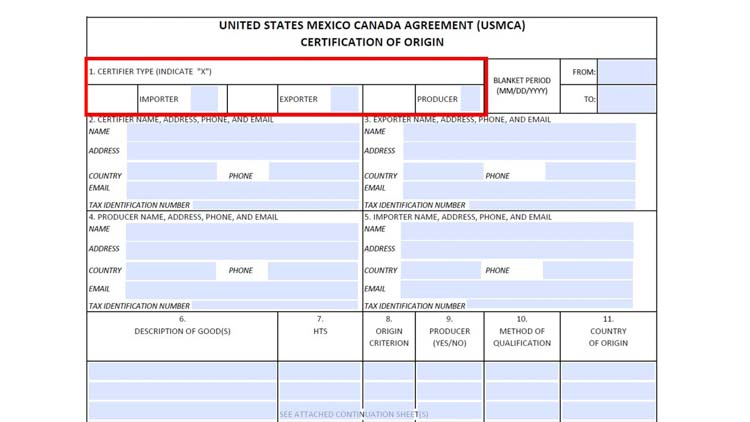
BLANKET PERIOD
Indicate the duration of the Certificate. The blanket period cannot exceed a period of one year.
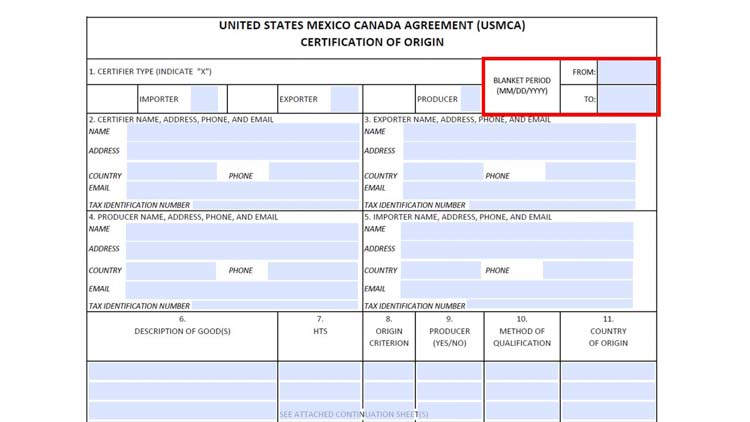
FIELD 2 - CERTIFIER
Provide the Certifier’s company name, address (including country), e-mail address, and telephone number.
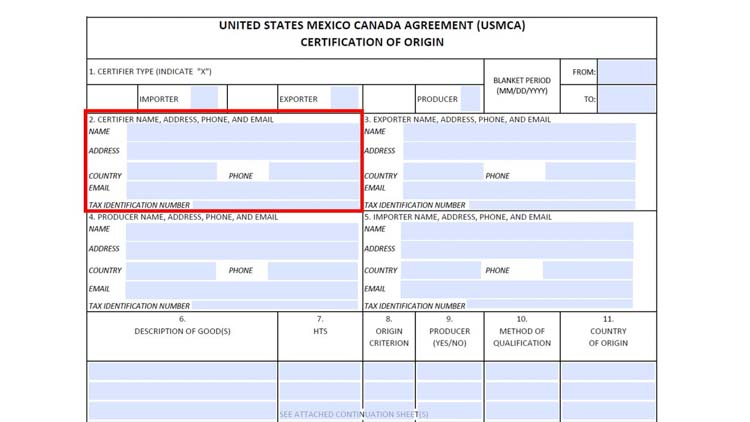
FIELD 3 - EXPORTER
Provide the Exporter’s name, address (including country), e-mail address, and telephone number if different from the certifier. This information is not required if the producer is completing the certification of origin and does not know the identity of the exporter; in which case you may state “Unknown.” The address of the exporter shall be the place of export of the good in a Party’s territory. If the information is the same as the Certifier, you may state “Same as Certifier.”
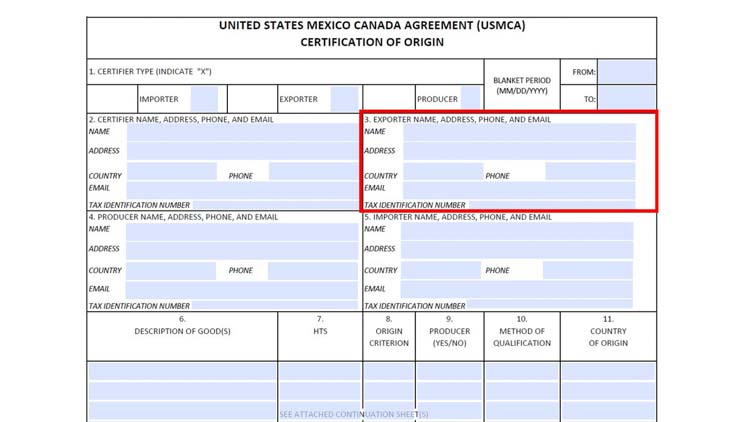
FIELD 4 - PRODUCER
Provide the Producer’s name, address (including country), e-mail address, and telephone number, if different from the certifier or exporter. If there are multiple producers, you may state “Various” or provide a list of producers. If this information is to remain confidential, you may state “Available upon request by the importing authorities”. The address of a producer shall be the place of production of the good in a Party’s territory. If the information is the same as the Certifier, you may state “Same as Certifier.”
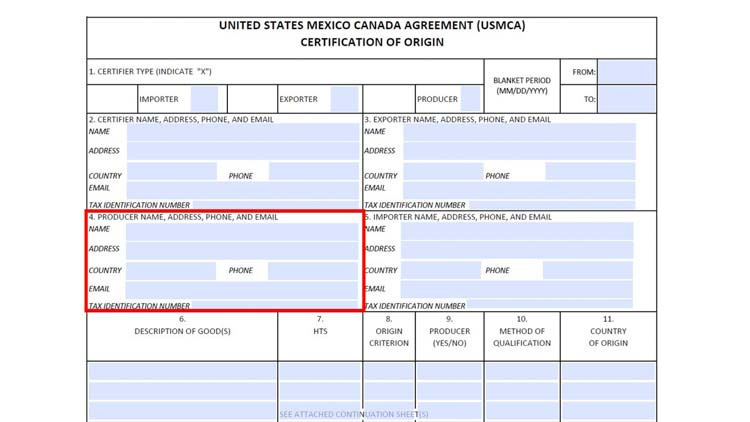
FIELD 5 - IMPORTER
Provide, if known, the Importer’s name, address, e-mail address, and telephone number. The address of the importer shall be in a Party’s territory. If the importer name and address are not known or there are multiple importing locations, you may state “Various.”
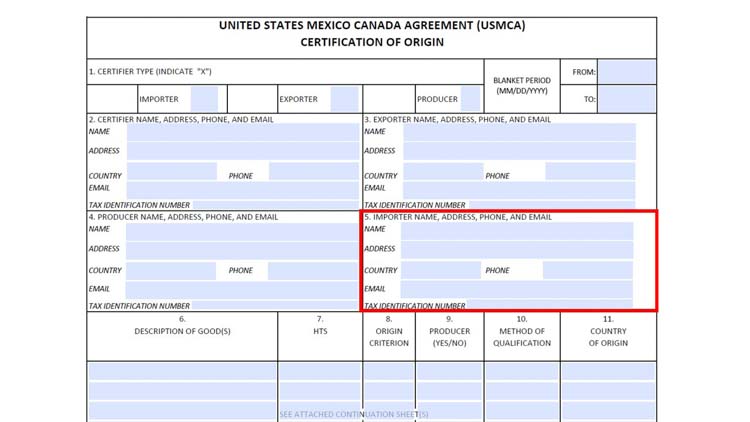
FIELD 6 - DESCRIPTION
Provide a description of the good. The description should be sufficient to relate it to the good covered by the certification.
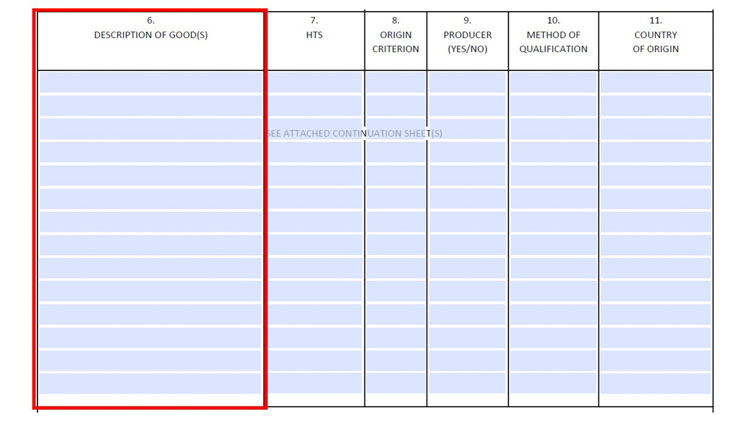
FIELD 7 - HTS
Provide the Harmonized Tariff Schedule classification to the 6-digit level for each good described in Field 6
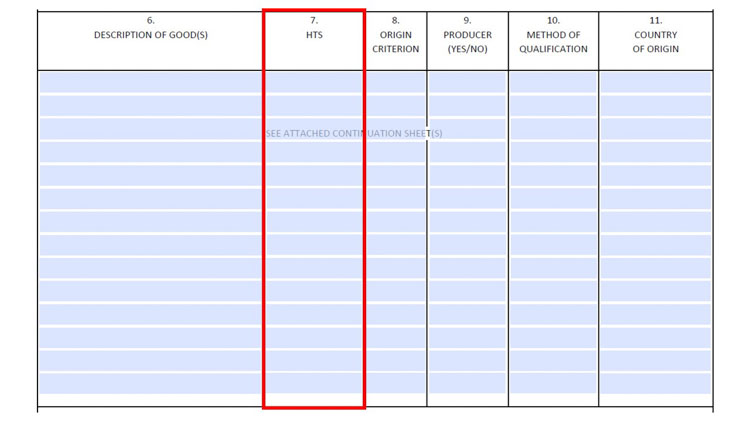
FIELD 8 - ORIGIN CRITERION
Specify the origin criterion (A, B, C, D, or E) under which the good qualifies, as set out in Article 4.2 (Originating Goods):
A – Wholly obtained or produced entirely in the territory of one or more of the Parties, as defined in Article 4.3 (Wholly Obtained or Produced Goods)
B – Produced entirely in the territory of one or more of the Parties using non-originating materials provided the good satisfies all applicable requirements of Annex 4-B (Product-Specific Rules of Origin)
C – Produced entirely in the territory of one or more of the Parties exclusively from originating materials
D – “Except for a good provided for in Chapter 61 to 63 of the Harmonized System:
(i) produced entirely in the territory of one or more of the Parties;
(ii) one or more of the non-originating materials provided for as parts under the Harmonized System used in the production of the good cannot satisfy the requirements set out in Annex 4-B (Product-Specific Rules of Origin) because both the good and its materials are classified in the same subheading or same heading that is not further subdivided into subheadings or, the good was imported into the territory of a Party in an unassembled or a disassembled form but was classified as an assembled good pursuant to rule 2(a) of the General Rules of Interpretation of the Harmonized System; and
(iii) the regional value content of the good, determined in accordance with Article 4.5 (Regional Value Content), is not less than 60 percent if the transaction value method is used, or not less than 50 percent if the net cost method is used”
E – The goods provided for under the tariff provisions set out in Chapter 2 – Table 2.10.1, Table 2.10.2, and Table 2.10.3.
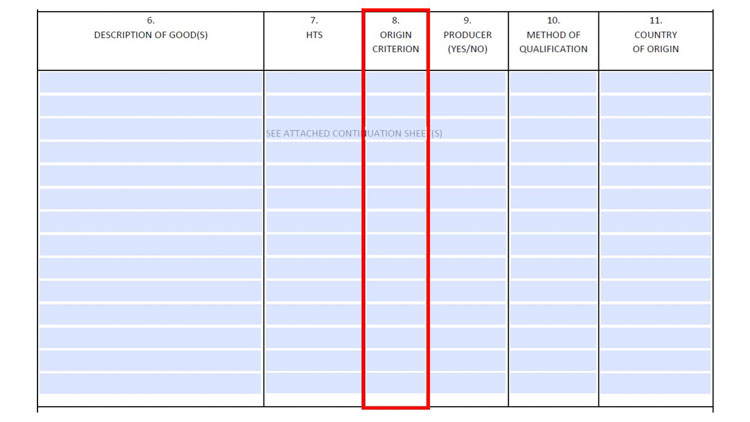
FIELD 9 - PRODUCER
For each good described in Field 6, where you are the Producer of the good, indicate “YES”; otherwise indicate “NO.”
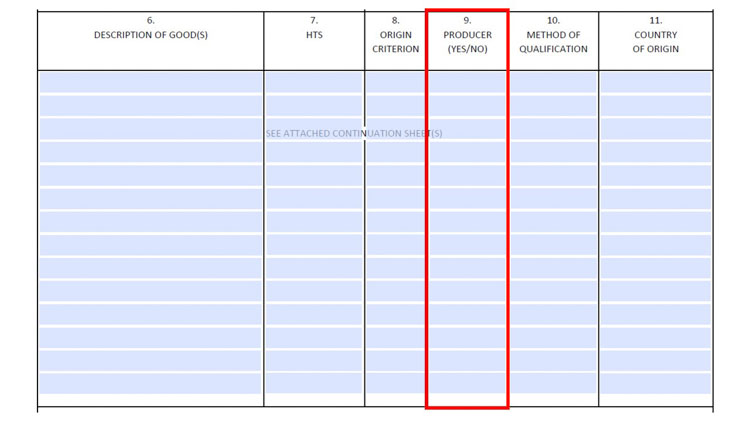
FIELD 10 - METHOD OF QUALIFICATION
For each good described in Field 6, where the good is subject to a Regional Value Content (RVC) requirement, indicate “NC” if the RVC was calculated according to the Net Cost method and “TV” if the good was calculated according to the Transaction Value method. If the good was qualified via a tariff shift, indicate “TS.” If Origin Criterion A or C, you may enter “NO.”
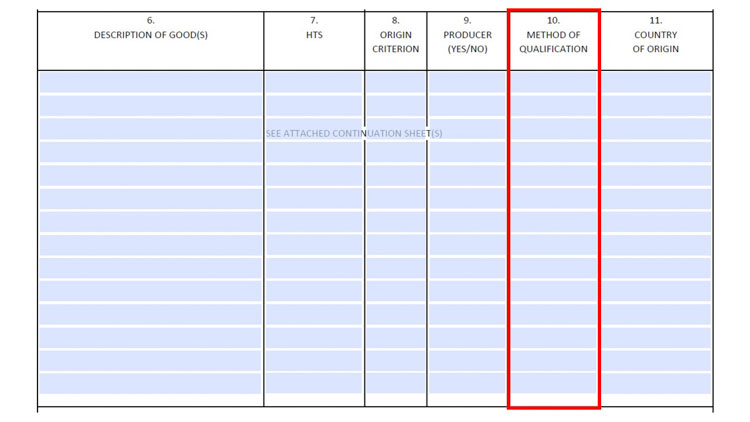
FIELD 11 - COUNTRY OF ORIGIN
Identify the country of origin of the good using the ISO Country Code (e.g. “CA”, “US”, “MX”)
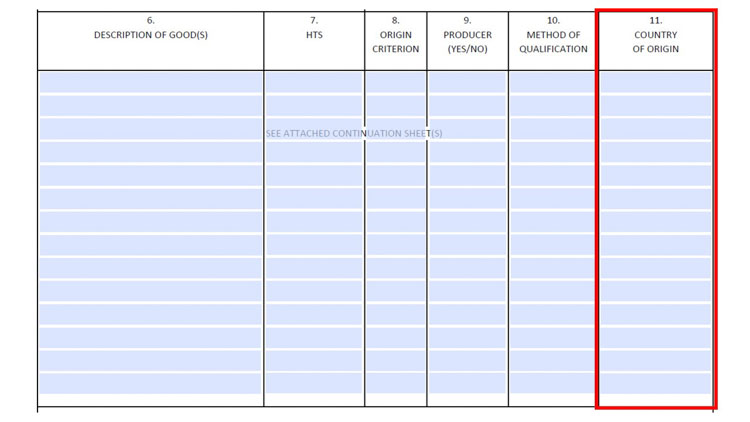
PAGE COUNT
Include the total page count of the cover page + continuation page(s) containing eligible parts only. Non-Eligibles addendum and Instructions should NOT be part of total page count.

FIELD 12 - SIGNATURE BLOCK
This field must be completed, signed, and dated by the authorized Certifier. The date must be the date the Certificate was completed and signed. Indicate Certifier’s Company, Title, Telephone Number, and Email Address.

NON ELIGIBLES ADDENDUM - ACCUMULATION VALUE
In accordance with the United States Mexico Canada Agreement regulations, under 19 CFR 182 Appendix A, Section 9, Paragraph 2(b), indicate the amount of originating content for Not Eligible goods that last underwent production in the US, CA, or MX. This should be in a per-unit amount and be in USD. Parts of non-US, MX, CA origin can only have accumulated value if the last country in which they underwent production was the US, CA, or MX. E.g. If China origin part contains US components, but last country of production was CN, Accumulated Value would be $0. A final packaging/re-packaging operation in the US does not constitute “production.”
Latest USMCA News
U.S. Trade Representative Robert Lighthizer today notified Congress that the United States–Mexico–Canada Agreement (USMCA) will enter into force on July 1, 2020.
Congressional members send letter to the USTR requesting “flexibility” on the implementation of USMCA’s automotive rules of origin.
Canada Border Services Agency (CBSA) publishes Customs Notice on CUSMA implementation.
Frequently Asked Questions
Is there a form issued by the governments of the US, Canada, or Mexico that I can use instead?
No. Unlike NAFTA, which had a published government form (for the US, CBP had the Customs Form 434 NAFTA Certificate of Origin), there is no such requirement under USMCA.
How do I know which Rule of Origin to analyze?
Chapter 4 of the USMCA (see Resources & Helpful Links) contains product specific Rules of Origin, these will be reflected in the General Note 11 of the Harmonized Tariff Schedule of the United States (HTSUS) when updated. In order to determine the proper analysis of a good, you must know (and be confident in) the HTS Number of the good. This will dictate the Rule of Origin to analyze and determine eligibility. For certain goods there are unique and complex Rules of Origin in the USMCA (e.g. automotive goods, textiles, textile apparel products, etc.).
Can I use my supplier NAFTA documents to support a USMCA qualification?
No, USMCA qualifications need to be supported by supplier USMCA documents, where applicable.
Why does the USMCA Certification of Origin on this website have data elements beyond the ‘minimum data elements’ listed in the text of the agreement?
The downloadable certificate includes the minimum requirements, with additional data elements based on evolving industry practices which are subject to change.
I already certified my good for NAFTA, so my good must be “eligible” for USMCA too, right?
Not necessarily. The USMCA contains its own, specific Rules of Origin (ROO) and if a good qualified for NAFTA it does not mean it will qualify for USMCA.
Is my good an “originating good”?
Similar to NAFTA, the USMCA contains a list of product-specific, Rules of Origin (ROO) that must be followed for determining if an item is an “originating good” and entitled to duty-free benefits.
The rules are aimed at ensuring “originating goods” are those that were produced in the United States, Mexico, or Canada and have a production process that generated a sufficient amount of investment in any-or-all of the three member countries (e.g. had significant labor cost, a complex manufacturing process, or the good included large amount of other, originating components). The ROO also prevents items of non-North American origin, undergoing only minor production, from claiming the duty-free benefits.
The ROO’s are not subjective, they clearly state the amount of Regional Value Content (RVC) necessary to qualify and/or the manufacturing processes necessary based on the components of the good. Typically, a proper analysis/calculation of the product specific ROO utilizing a current costed Bill of Material will be required to determine if a good is an “originating good” or not.
MORE QUESTIONS?
Let us help you with your USMCA needs! We can analyze your goods, solicit your suppliers, and even manage your broker/customer requests.
SPEAK TO A TRADE COMPLIANCE SPECIALIST
The team of experienced trade professionals at FOCUS Business Solutions, Inc. have been helping companies manage free trade agreement duty savings and compliance programs for more than 20 years. Contact our team to see how we can help you manage your USMCA needs.

